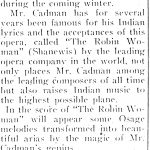October 4, 1917
The Osage Journal
Microfilm Roll: MN00318
On this day in Osage country, The Osage Journal published an article regarding the production of an upcoming opera.
Charles Wakefield Cadman, an American composer, was well-known for his “Indian” operas. Born in Johnstown, Pennsylvania, Cadman developed an early interest in music and educated himself in music as much as he could. As a young man his father fell very ill, so Cadman used his musical talents to help support his family. A few years later Alice Fletcher, an ethnologist, convinced Cadman to visit the Omaha tribe for the duration of a summer. While living among the Omaha, Cadman became fascinated with their forms of music and dance, and in turn pushed himself to learn to play their unique instruments. From the Land of the Sky-Blue Water, a song he composed after being influenced by Indian music, placed the public spotlight on Cadman’s name. His opera, Shanewis (The Robin Woman), would truly prove to bring Cadman to fame.
According to the article, Cadman was working on his composition of Shanewis which was already set to be shown at the Metropolitan Opera Company in New York. Being accepted by such a prestigious opera company “place[d] Mr. Cadman among the leading composers of all time, but also raise[d] Indian music to the highest possible plane.” A local by the name of A. T. Woodward helped Cadman prepare for the show Shanewis, which featured Osage music-“music of her own tribe.”
The production of Shanewis was a huge success. On opening night, “at the end of the performance, there were twenty-one curtain calls,” (Baisley). Furthermore, the opera became the “first American opera to be presented during two consecutive years at the Metropolitan Opera House,” (Baisley).
Morgan M. Guzman
“Indian Music in Opera.” The Osage Journal. October 4, 1917, p. 1. Microfilm roll number MN00318. Sequoyah National Research Center, Little Rock, Arkansas.
Further Reading
Baisley, Robert W. “Charles Wakefield Cadman: Completely American.” Music Educators Journal 61, no. 9 (1975): 56-58.
